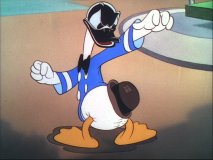Starting as a cartoonist
Bambi (1942) While Barks was working in the story department at the Disney studios he got the opportunity to contribute gags for the upcoming Bambi feature animated film. He hatched the memorable scene in which the faun encounters an icy lake for the first time in its life and he contributed a series of roughs showing the action. A few of them are shown here. Barks contributed another idea for the film. A few of his roughs are seen here. It is a scene in which a squirrel tries to teach a chipmunk how to crack a nut. The scene was never used in the finished film. |
